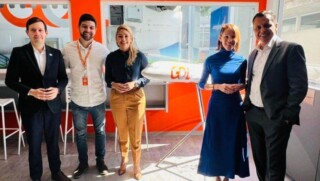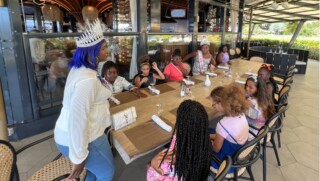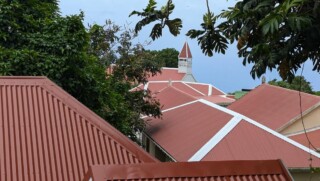Sustainability Saba Government Good; Still Room for Improvement

The Bottom, Saba- Public Entity Saba is progressing in the area of sustainability within the government organization, but there are still areas with room for improvement.
Tom van Haaren, architect specialized in sustainability in a built environment, arrived at that conclusion during his five-month stay on Saba as trainee.
Van Haaren looked at five categories: energy, materials, waste, water and health & wellbeing. He took the government administration building, the archives building and the Planning Bureau as case study, but the findings can be generally applied to the 15 to 20 government buildings.
Van Haaren also looked at how the traditional Saban building style includes sustainable values. The use of white walls on Saba are a sustainable element in the building style because white reflects heat and as such less energy is needed to cool the inside of buildings. The relatively small windows are also a positive element because less heat gets inside the building and the cool air stays inside.
Cisterns
The use of cisterns is super sustainable, in Van Haaren’s opinion. “The Netherlands can learn something from Saba where the catching of rainwater and the very efficient use of water by the Saban people is concerned,” he said. According to Van Haaren, Saba is doing well in the area of sustainability, but he did have a number of recommendations for further improvements.
Van Haaren recommended replacing the old central air conditioning units in the government administration building which are not energy efficient. The insulation of roofs is a very effective manner to prevent the loss of energy and it can save 5 to 10 percent of the total electricity bill. Also, the reduction of the number of printers at the offices can be reduced to save energy, to decrease waste, to improve the air quality and to stimulate employees to walk more.
Government has started to apply its general objective to drastically limit single use plastics, which is a good thing. The use of plastic bottles and Styrofoam cups within the government organization is being phased out. Government workers have been given their own mug that they can reuse. Styrofoam cups will be replaced by paper cups.
Water dispensers
As a pilot project, water dispensers will be installed in the different government buildings. The idea is to initially import the large refillable bottles with water from St. Maarten until the water bottling plant on Saba has become fully operational. The close to 200 government workers will receive a personal Dopper water bottle that they can refill at the water dispensers.
Where it concerns the use and purchase of materials by government, Van Haaren recommends to use materials with a lower carbon foot print and to purchase materials according to the Sustainable Public Procurement principle. The Dutch Government developed and applies this principle through the Ministry of Economic Affairs and Climate Policy (EZK). The persons in charge of purchasing at the Public Entity Saba will be taking part in an introduction course from EZK to learn about the life cycle of products and their sustainability.
Plants
To improve the health and wellbeing of government workers, Van Haaren recommends placing plants in the government buildings, investigate air quality and, if necessary, take measures to improve ventilation. Scientific research has shown that having plants inside offices already improves the air quality and results in less stress and fewer sick days. The placing of plants will be done in cooperation with the Saba Reach Foundation.
Van Haaren applied the so-called “Trias Energetica” principle in his assessment of sustainability within the Saba Government. Point one is to reduce the demand for energy by avoiding waste and implementing energy-saving measures. The isolation of roofs and installing timers on the air-conditioners are good examples of this.
Solar park
Point two is to use sustainable sources of energy instead of fossil fuel. In that sense, the recently constructed solar park of the Saba Electric Company (SEC) is a very positive development. Point three is to produce and use fossil energy as efficient as possible. Van Haaren said that the Public Entity Saba has attention for energy, waste and water, but that more attention is needed for the use of sustainable materials and for health & wellbeing. In his opinion, there are several quick wins in the latter two areas.
While on Saba, Van Haaren carried out an indoor environment survey within government by asking civil servants what they thought of their work place, the air quality and the amount of light. Van Haaren said the response to that survey was good. “Some people indicated that they would like to see a better air quality and temperature. People were generally positive about the amount of noise and light at their workplace.”
Van Haaren’s stay on Saba from late September 2018 to late February 2019 was financed through the Ministry of Home Affairs and Kingdom Relations BZK.












